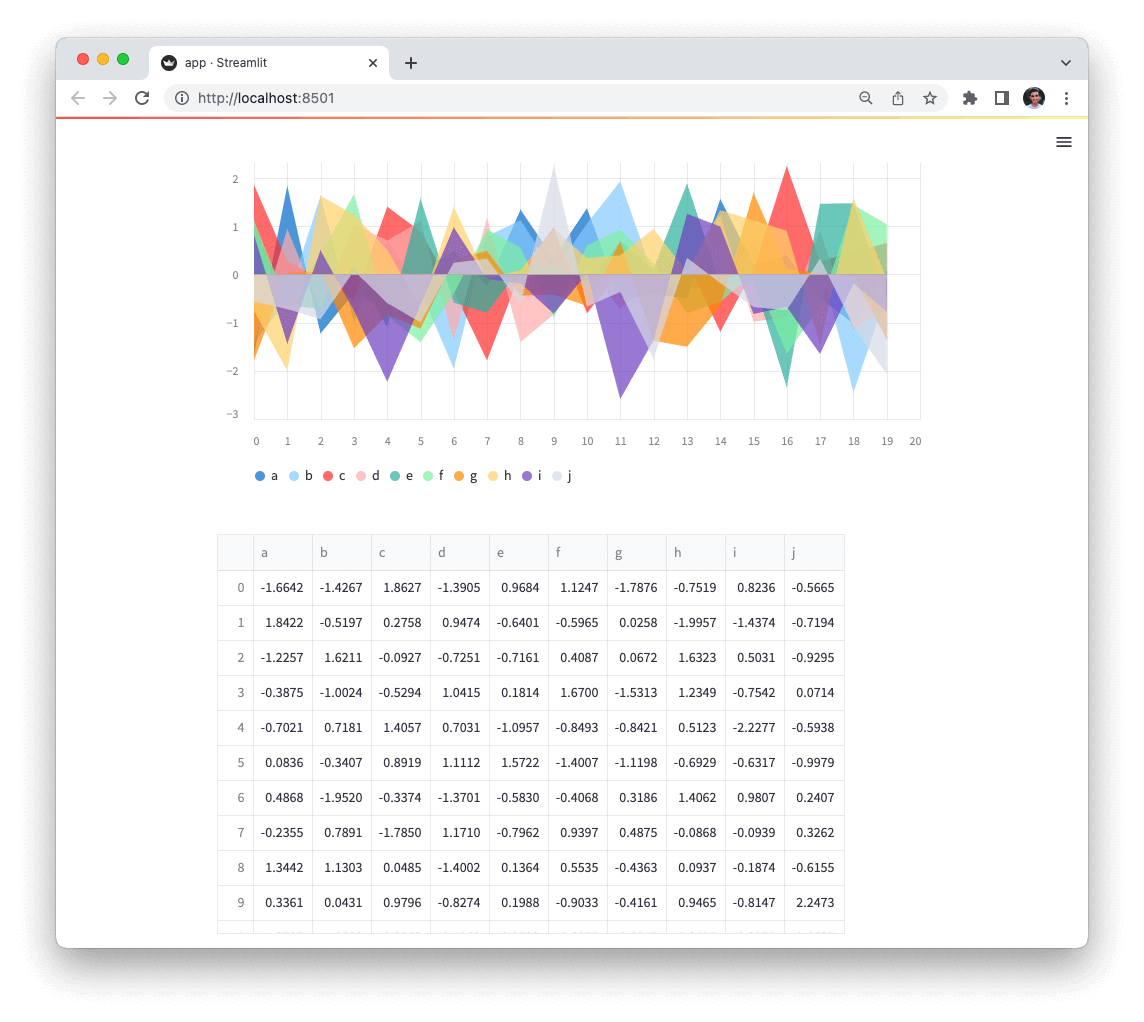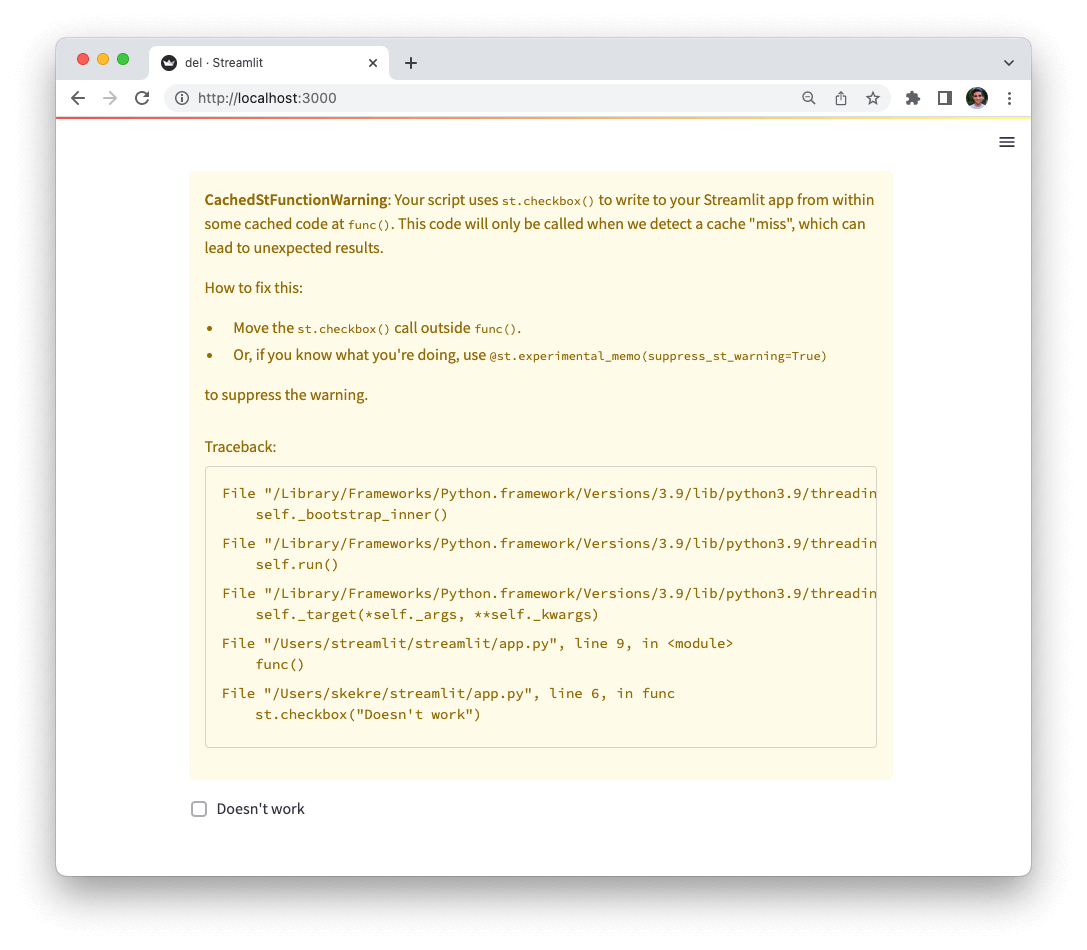Important
This is an experimental feature. Experimental features and their APIs may change or be removed at any time. To learn more, click here.
Persistent memo caches currently don't support TTL. ttl will be ignored if persist is specified:
import streamlit as st
@st.experimental_memo(ttl=60, persist="disk")
def load_data():
return 42
st.write(load_data())
And a warning will be logged to your terminal:
streamlit run app.py
You can now view your Streamlit app in your browser.
Local URL: http://localhost:8501
Network URL: http://192.168.1.1:8501
2022-09-22 13:35:41.587 The memoized function 'load_data' has a TTL that will be ignored. Persistent memo caches currently don't support TTL.
Warning
This method did not exist in version 1.41.0 of Streamlit.
Example
In the example below, pressing the "Clear All" button will clear memoized values from all functions decorated with @st.experimental_memo.
import streamlit as st
@st.experimental_memo
def square(x):
return x**2
@st.experimental_memo
def cube(x):
return x**3
if st.button("Clear All"):
# Clear values from *all* memoized functions:
# i.e. clear values from both square and cube
st.experimental_memo.clear()
Replay static st elements in cache-decorated functions
Functions decorated with @st.experimental_memo can contain static st elements. When a cache-decorated function is executed, we record the element and block messages produced, so the elements will appear in the app even when execution of the function is skipped because the result was cached.
In the example below, the @st.experimental_memo decorator is used to cache the execution of the load_data function, that returns a pandas DataFrame. Notice the cached function also contains a st.area_chart command, which will be replayed when the function is skipped because the result was cached.
import numpy as np
import pandas as pd
import streamlit as st
@st.experimental_memo
def load_data(rows):
chart_data = pd.DataFrame(
np.random.randn(rows, 10),
columns=["a", "b", "c", "d", "e", "f", "g", "h", "i", "j"],
)
# Contains a static element st.area_chart
st.area_chart(chart_data) # This will be recorded and displayed even when the function is skipped
return chart_data
df = load_data(20)
st.dataframe(df)

Supported static st elements in cache-decorated functions include:
st.alertst.altair_chartst.area_chartst.audiost.bar_chartst.ballonsst.bokeh_chartst.captionst.codest.components.v1.htmlst.components.v1.iframest.containerst.dataframest.echost.emptyst.errorst.exceptionst.expanderst.experimental_get_query_paramsst.experimental_set_query_paramsst.formst.form_submit_buttonst.graphviz_chartst.helpst.imagest.infost.jsonst.latexst.line_chartst.markdownst.metricst.plotly_chartst.progressst.pydeck_chartst.snowst.spinnerst.successst.tablest.textst.vega_lite_chartst.videost.warning
Replay input widgets in cache-decorated functions
In addition to static elements, functions decorated with @st.experimental_memo can also contain input widgets! Replaying input widgets is disabled by default. To enable it, you can set the experimental_allow_widgets parameter for @st.experimental_memo to True. The example below enables widget replaying, and shows the use of a checkbox widget within a cache-decorated function.
import streamlit as st
# Enable widget replay
@st.experimental_memo(experimental_allow_widgets=True)
def func():
# Contains an input widget
st.checkbox("Works!")
func()
If the cache decorated function contains input widgets, but experimental_allow_widgets is set to False or unset, Streamlit will throw a CachedStFunctionWarning, like the one below:
import streamlit as st
# Widget replay is disabled by default
@st.experimental_memo
def func():
# Streamlit will throw a CachedStFunctionWarning
st.checkbox("Doesn't work")
func()

How widget replay works
Let's demystify how widget replay in cache-decorated functions works and gain a conceptual understanding. Widget values are treated as additional inputs to the function, and are used to determine whether the function should be executed or not. Consider the following example:
import streamlit as st
@st.experimental_memo(experimental_allow_widgets=True)
def plus_one(x):
y = x + 1
if st.checkbox("Nuke the value 💥"):
st.write("Value was nuked, returning 0")
y = 0
return y
st.write(plus_one(2))
The plus_one function takes an integer x as input, and returns x + 1. The function also contains a checkbox widget, which is used to "nuke" the value of x. i.e. the return value of plus_one depends on the state of the checkbox: if it is checked, the function returns 0, otherwise it returns 3.
In order to know which value the cache should return (in case of a cache hit), Streamlit treats the checkbox state (checked / unchecked) as an additional input to the function plus_one (just like x). If the user checks the checkbox (thereby changing its state), we look up the cache for the same value of x (2) and the same checkbox state (checked). If the cache contains a value for this combination of inputs, we return it. Otherwise, we execute the function and store the result in the cache.
Let's now understand how enabling and disabling widget replay changes the behavior of the function.
Widget replay disabled
- Widgets in cached functions throw a
CachedStFunctionWarningand are ignored. - Other static elements in cached functions replay as expected.
Widget replay enabled
- Widgets in cached functions don't lead to a warning, and are replayed as expected.
- Interacting with a widget in a cached function will cause the function to be executed again, and the cache to be updated.
- Widgets in cached functions retain their state across reruns.
- Each unique combination of widget values is treated as a separate input to the function, and is used to determine whether the function should be executed or not. i.e. Each unique combination of widget values has its own cache entry; the cached function runs the first time and the saved value is used afterwards.
- Calling a cached function multiple times in one script run with the same arguments triggers a
DuplicateWidgetIDerror. - If the arguments to a cached function change, widgets from that function that render again retain their state.
- Changing the source code of a cached function invalidates the cache.
- Both
st.experimental_memoandst.experimental_singletonsupport widget replay. - Fundamentally, the behavior of a function with (supported) widgets in it doesn't change when it is decorated with
@st.experimental_memoor@st.experimental_singleton. The only difference is that the function is only executed when we detect a cache "miss".
Supported widgets
All input widgets are supported in cache-decorated functions. The following is an exhaustive list of supported widgets:
st.buttonst.camera_inputst.checkboxst.color_pickerst.date_inputst.download_buttonst.file_uploaderst.multiselectst.number_inputst.radiost.selectboxst.select_sliderst.sliderst.text_areast.text_inputst.time_input
Still have questions?
Our forums are full of helpful information and Streamlit experts.